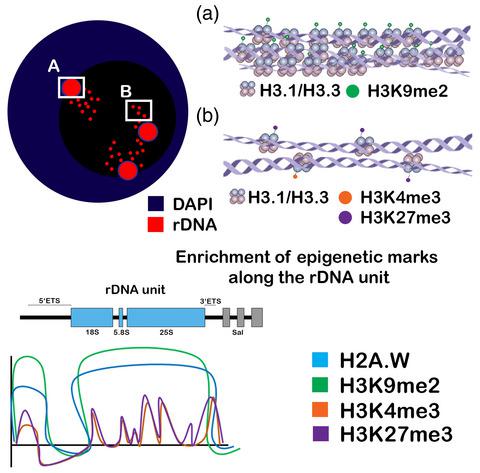Our official English website, www.x-mol.net, welcomes your
feedback! (Note: you will need to create a separate account there.)
Nucleolar rDNA folds into condensed foci with a specific combination of epigenetic marks
The Plant Journal ( IF 6.2 ) Pub Date : 2020-12-12 , DOI: 10.1111/tpj.15130 Konstantin O Kutashev 1, 2 , Michal Franek 1 , Klev Diamanti 3, 4 , Jan Komorowski 3, 5 , Marie Olšinová 6 , Martina Dvořáčková 1
The Plant Journal ( IF 6.2 ) Pub Date : 2020-12-12 , DOI: 10.1111/tpj.15130 Konstantin O Kutashev 1, 2 , Michal Franek 1 , Klev Diamanti 3, 4 , Jan Komorowski 3, 5 , Marie Olšinová 6 , Martina Dvořáčková 1
Affiliation

|
Arabidopsis thaliana 45S ribosomal genes (rDNA) are located in tandem arrays called nucleolus organizing regions on the termini of chromosomes 2 and 4 (NOR2 and NOR4) and encode rRNA, a crucial structural element of the ribosome. The current model of rDNA organization suggests that inactive rRNA genes accumulate in the condensed chromocenters in the nucleus and at the nucleolar periphery, while the nucleolus delineates active genes. We challenge the perspective that all intranucleolar rDNA is active by showing that a subset of nucleolar rDNA assembles into condensed foci marked by H3.1 and H3.3 histones that also contain the repressive H3K9me2 histone mark. By using plant lines containing a low number of rDNA copies, we further found that the condensed foci relate to the folding of rDNA, which appears to be a common mechanism of rDNA regulation inside the nucleolus. The H3K9me2 histone mark found in condensed foci represents a typical modification of bulk inactive rDNA, as we show by genome‐wide approaches, similar to the H2A.W histone variant. The euchromatin histone marks H3K27me3 and H3K4me3, in contrast, do not colocalize with nucleolar foci and their overall levels in the nucleolus are very low. We further demonstrate that the rDNA promoter is an important regulatory region of the rDNA, where the distribution of histone variants and histone modifications are modulated in response to rDNA activity.
中文翻译:

核仁 rDNA 折叠成具有特定表观遗传标记组合的凝聚灶
拟南芥45S 核糖体基因 (rDNA) 位于 2 号和 4 号染色体(NOR2 和 NOR4)末端的称为核仁组织区的串联阵列中,并编码 rRNA,这是核糖体的关键结构元件。当前的 rDNA 组织模型表明,无活性的 rRNA 基因在细胞核和核仁外围的浓缩色质中心积累,而核仁则描绘了活性基因。我们通过显示核仁 rDNA 的一个子集组装成由 H3.1 和 H3.3 组蛋白标记的浓缩病灶来挑战所有核仁内 rDNA 都是活跃的观点,这些组蛋白还包含抑制性 H3K9me2 组蛋白标记。通过使用含有少量 rDNA 拷贝的植物品系,我们进一步发现凝聚灶与 rDNA 的折叠有关,这似乎是核仁内 rDNA 调节的常见机制。在浓缩病灶中发现的 H3K9me2 组蛋白标记代表了大量无活性 rDNA 的典型修饰,正如我们通过全基因组方法显示的那样,类似于 H2A.W 组蛋白变体。相比之下,常染色质组蛋白标记 H3K27me3 和 H3K4me3 不与核仁病灶共定位,它们在核仁中的总体水平非常低。我们进一步证明 rDNA 启动子是 rDNA 的重要调控区域,其中组蛋白变体和组蛋白修饰的分布受 rDNA 活性调节。不与核仁病灶共定位,它们在核仁中的总体水平非常低。我们进一步证明 rDNA 启动子是 rDNA 的重要调控区域,其中组蛋白变体和组蛋白修饰的分布受 rDNA 活性调节。不与核仁病灶共定位,它们在核仁中的总体水平非常低。我们进一步证明 rDNA 启动子是 rDNA 的重要调控区域,其中组蛋白变体和组蛋白修饰的分布受 rDNA 活性调节。
更新日期:2020-12-12
中文翻译:

核仁 rDNA 折叠成具有特定表观遗传标记组合的凝聚灶
拟南芥45S 核糖体基因 (rDNA) 位于 2 号和 4 号染色体(NOR2 和 NOR4)末端的称为核仁组织区的串联阵列中,并编码 rRNA,这是核糖体的关键结构元件。当前的 rDNA 组织模型表明,无活性的 rRNA 基因在细胞核和核仁外围的浓缩色质中心积累,而核仁则描绘了活性基因。我们通过显示核仁 rDNA 的一个子集组装成由 H3.1 和 H3.3 组蛋白标记的浓缩病灶来挑战所有核仁内 rDNA 都是活跃的观点,这些组蛋白还包含抑制性 H3K9me2 组蛋白标记。通过使用含有少量 rDNA 拷贝的植物品系,我们进一步发现凝聚灶与 rDNA 的折叠有关,这似乎是核仁内 rDNA 调节的常见机制。在浓缩病灶中发现的 H3K9me2 组蛋白标记代表了大量无活性 rDNA 的典型修饰,正如我们通过全基因组方法显示的那样,类似于 H2A.W 组蛋白变体。相比之下,常染色质组蛋白标记 H3K27me3 和 H3K4me3 不与核仁病灶共定位,它们在核仁中的总体水平非常低。我们进一步证明 rDNA 启动子是 rDNA 的重要调控区域,其中组蛋白变体和组蛋白修饰的分布受 rDNA 活性调节。不与核仁病灶共定位,它们在核仁中的总体水平非常低。我们进一步证明 rDNA 启动子是 rDNA 的重要调控区域,其中组蛋白变体和组蛋白修饰的分布受 rDNA 活性调节。不与核仁病灶共定位,它们在核仁中的总体水平非常低。我们进一步证明 rDNA 启动子是 rDNA 的重要调控区域,其中组蛋白变体和组蛋白修饰的分布受 rDNA 活性调节。











































 京公网安备 11010802027423号
京公网安备 11010802027423号